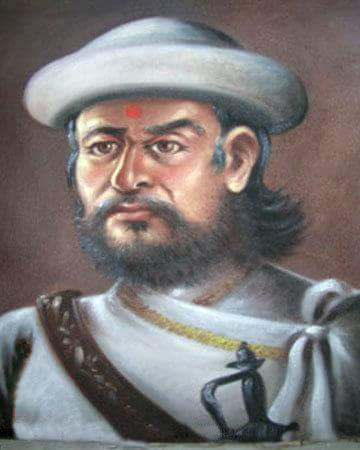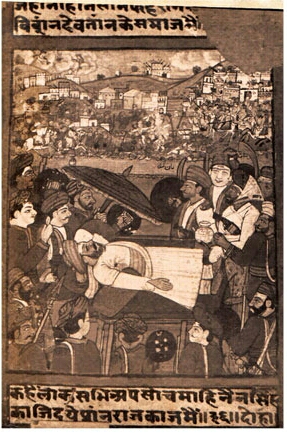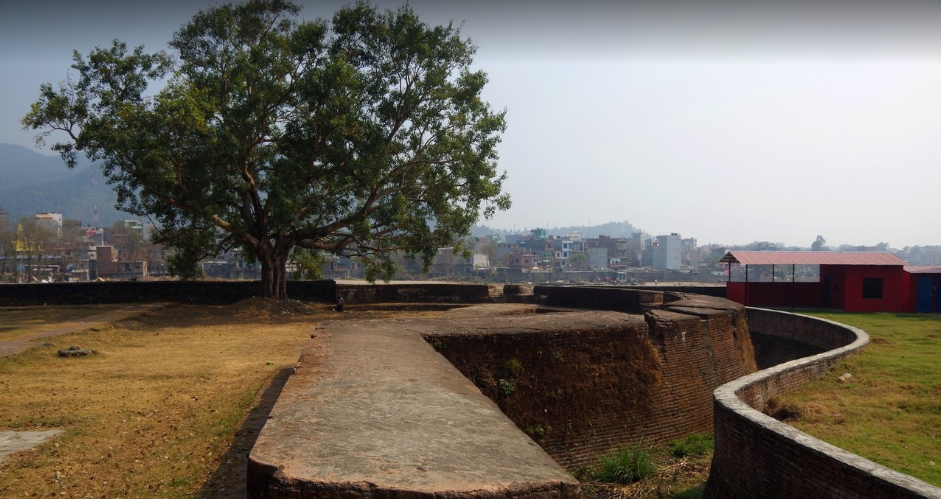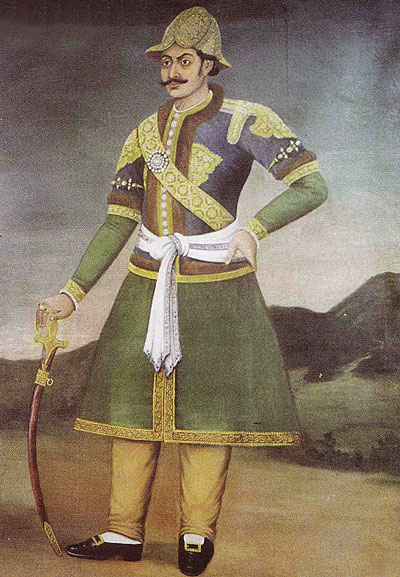|
Ranajit Pande
Ranajit Pande ( ne, रणजीत पाँडे) was Nepalese politician, military personnel and courtier in the Kingdom of Nepal. He was member of the Gora Pande clan of Gorkha. He became Mulkaji of Nepal for a brief period in 1804 A.D. Family He was born as the second son of Tularam Pande on 1809 Vikram Samvat (1752 A.D.). His ancestors as per the inscription installed by his brother ''Kapardar'' Bhotu Pande shows Tularam, Baliram and Birudatta in the three generations. Relation with Thapas He had a daughter Rana Kumari Pande who was married to ''Thapa Kaji'' Nain Singh Thapa. Their children were Mathabarsingh Thapa, Ganesh Kumari (mother of Jang Bahadur Rana, Queen Tripurasundari of Nepal and Colonel Ujir Singh Thapa. *Ganesh Kumari is mother of Jung Bahadur Rana, founder of Rana dynasty. Career Sino Nepalese war He also fought in the Sino-Nepalese War as subordinate commander under Chautariya Kaji Krishna Shah. As a Mulkaji of Nepal After the execution o ... [...More Info...] [...Related Items...] OR: [Wikipedia] [Google] [Baidu] |
Mulkaji
''Mulkaji'' ( ne, मूलकाजी) was the position of head of executive of Kingdom of Nepal in the late 18th and early 19th centuries. It was equivalent to Prime Minister of Nepal. There were 5 Mulkajis appointed between 1785 and 1804. Meaning ''Mulkaji'' is formed from two words: ''Mul'' and ''Kaji''. ''Mul'' means ''Chief'', ''Key'' or ''Fundamental'' and ''Kaji'' is derived from Sanskrit word ''Karyi'' which meant ''functionary''. Altogether it means ''Chief Functionary'' or ''Executive Head of the State''. History of the five Mulkajis Abhiman Singh Basnyat Dewan Kaji Bamsa Raj Pande was beheaded on March 1785 on the conspiracy of Queen Rajendra Laxmi with the help of supporters including senior Kaji Swaroop Singh Karki. On 2 July 1785, Prince Regent Bahadur Shah of Nepal was arrested and on the eleventh day of imprisonment on 13 July, Queen Rajendra Laxmi died. Then onwards, Bahadur Shah of Nepal took over the regency of his nephew King Rana Bahadur Shah and the ... [...More Info...] [...Related Items...] OR: [Wikipedia] [Google] [Baidu] |
Nain Singh Thapa
Nain Singh Thapa or Nayan Singh Thapa ( ne, नैनसिंह थापा/नयनसिंह थापा) (died late 1806 or early 1807) was a Nepalese Kaji (minister) and a military general. He died in the offensive campaign of Kangra from bullet injury. He was the owner of the Thapathali Durbar temple complex. Career He was a Kaji and General of Nepal Army. A royal order was decreed on Ashwin Sudi 2, 1862 V.S. (September 1805), for the preparations of Kangra campaign. In September 1805, while being deputed at Kangra Fort, his brother Mukhtiyar Bhimsen Thapa ordered him to arrest military deserters. Gorkhali forces under Badakaji Amar Singh Thapa, Rudrabir hahand Nain Singh overran Nalagarh and crossed Sutlej river. They fought battle against King Sansar Chand at Mahal Mori in May 1806 and defeated him there. Sansar Chand fled to Kangra fort after taking refuge at Sujanpur Tira. Widow of Kirti Chand, Commander of Kangra Army and Nain Singh, the Nepalese commander led ... [...More Info...] [...Related Items...] OR: [Wikipedia] [Google] [Baidu] |
Mulkajis
''Mulkaji'' ( ne, मूलकाजी) was the position of head of executive of Kingdom of Nepal in the late 18th and early 19th centuries. It was equivalent to Prime Minister of Nepal. There were 5 Mulkajis appointed between 1785 and 1804. Meaning ''Mulkaji'' is formed from two words: ''Mul'' and ''Kaji''. ''Mul'' means ''Chief'', ''Key'' or ''Fundamental'' and ''Kaji'' is derived from Sanskrit word ''Karyi'' which meant ''functionary''. Altogether it means ''Chief Functionary'' or ''Executive Head of the State''. History of the five Mulkajis Abhiman Singh Basnyat Dewan Kaji Bamsa Raj Pande was beheaded on March 1785 on the conspiracy of Queen Rajendra Laxmi with the help of supporters including senior Kaji Swaroop Singh Karki. On 2 July 1785, Prince Regent Bahadur Shah of Nepal was arrested and on the eleventh day of imprisonment on 13 July, Queen Rajendra Laxmi died. Then onwards, Bahadur Shah of Nepal took over the regency of his nephew King Rana Bahadur Shah and the ... [...More Info...] [...Related Items...] OR: [Wikipedia] [Google] [Baidu] |
Ranganath Paudel
Ranga Nath Poudyal Atri ( ne, रङ्गनाथ पौड्याल) popularly known as Ranganath Pandit was the List of Prime Ministers of Nepal, Mukhtiyar of Nepal from 1837 December to 1838 August and in 1840 November for about 2–3 weeks. He was the first Brahmin Prime Minister of Nepal. Early life Ranga Nath Poudyal Atri was born in 1773 A.D. at Makhantole Kathmandu to Pandit Brajnath Atri, a who was prominent courtier in the palace who was later exiled to Benaras. He was a Bahun by ethnicity. Ranga Nath Poudyal Atri spent his childhood years in Benares, where he mastered Sanskrit. He was granted the title "Pandit Raj" by the then king of Benares. Political career Ranga Nath Poudyal Atri met Bhimsen Thapa in Benares (Varanasi). He was deeply influenced by Bhimsen Thapa and thus he forged his path to power by establishing himself as the prominent supporter of Bhimsen Thapa. After the execution of Mulkaji (Chief Kaji) Damodar Pande, Paudyal was appointed as Raj Guru (Ro ... [...More Info...] [...Related Items...] OR: [Wikipedia] [Google] [Baidu] |
Sher Bahadur Shah
Sher Bahadur Shah ( ne, शेरबहादुर शाह; January 1778 – 25 April 1806) was a Nepalese noble who served as Chautaria from 1794 until his assassination in 1806. He was the son of King Pratapsingh Shah and the 3rd dynasty royal prince of Nepal. Biography Sher Bahadur Shah was born at Hanuman Dhoka on January 1778 to King Pratap Singh Shah and Maiju Rani Maneshvari Devi. His mother was from a Newar family and the concubine of the king. Shah was promoted to Chautaria in 1794 by Rana Bahadur Shah. There was a conspiracy led by Prince Bahadur Shah, son of Prithvi Narayan Shah, to depose then king Rana Bahadur Shah and install Sher Bahadur Shah on the throne. In 1806, Shah assassinated his step-brother Rana Bahadur Shah, which ultimately led to the 1806 Bhandarkhal massacre. Sher Bahadur Shah was assassinated by Bal Narsingh Kunwar Bal Narsingh Kunwar or Balanarsingh Kanwar ( ne, बालनरसिंह कुँवर; 2 February 1783 - 24 Dec ... [...More Info...] [...Related Items...] OR: [Wikipedia] [Google] [Baidu] |
Rana Dynasty
Rana dynasty ( ne, राणा वंश, IAST=Rāṇā vaṃśa , ) is a Chhetri dynasty that imposed totalitarianism in the Kingdom of Nepal from 1846 until 1951, reducing the Shah monarch to a figurehead and making Prime Minister and other government positions held by the Ranas hereditary. They claimed Kshatriya status themselves. Rana dynasty is historically known for the '' iron-fisted rule''. This changed after the Revolution of 1951 with the promulgation of a new constitution, when power shifted back to the monarchy of King Tribhuvan. The Rana dynasty descended from the Kunwar family, a nobility of the Gorkha Kingdom. Due to the marital lineages with the politically reigning Thapa dynasty (of ''Mukhtiyar'' Bhimsen Thapa) from early 19th century, Ranas gained entry to central Darbar politics. Ranas were also linked to a minor faction of the Pande dynasty of Gorkha through the Thapa dynasty. Origins Chronicler Daniel Wright has published the genealogy of Jang Bahadur K ... [...More Info...] [...Related Items...] OR: [Wikipedia] [Google] [Baidu] |
Jung Bahadur Rana
Maharaja Jung Bahadur Kunwar Ranaji, (born Bir Narsingh Kunwar ( ne, वीर नरसिंह कुँवर), 18 June 1817; popularly known as Jung Bahadur Rana (JBR, ne, जङ्गबहादुर राणा)) () belonging to the Kunwar family was a Khas Chhetri ruler of Nepal and founder of the Rana Regime in Nepal. Jung Bahadur took control of the government after killing an alleged usurper Gagan Singh, who was accused of plotting with the junior queen in 1846 to become prime minister by putting the queen's son on the throne. His original name was Bir Narsingh Kunwar but he was popularly known as Jang Bahadur, a name given to him by his maternal uncle Mathabar Singh Thapa. Mathabar Singh Thapa used to call Jang Bahadur ''Jangay'' for his boldness. His mother Ganesh Kumari was the daughter of Kaji Nain Singh Thapa, brother of Mukhtiyar Bhimsen Thapa of the then prominent ruling Thapa dynasty. During his lifetime, he eliminated the factional fighting at the cour ... [...More Info...] [...Related Items...] OR: [Wikipedia] [Google] [Baidu] |
Ujir Singh Thapa
Ujir Singh Thapa or Uzir Singh Thapa ( ne, उजिरसिंह थापा), also known as Wazir Simha Thapa, anglicized as Wuzeer Singh, was Nepalese administrator and military officer. He was the son of Kaji Nain Singh Thapa, a nephew of the Mukhtiyar Bhimsen Thapa and elder brother of Mathabar Singh Thapa. His mother was Rana Kumari Pande, daughter of Mulkaji Ranajit Pande and granddaughter of Kaji Tularam Pande. During his late teenage, he was the military commander at the Palpa-Butwal axis during the Anglo-Nepalese War. He became the Governor (Bada Hakim) and the commander of armed forces deployed in Palpa administrative sector in 1814 AD on substitute of his grandfather Amar Singh Thapa (sanukaji) who died that year. Family and early life Ujir Singh was born on Chaitra ''Shukla Pratipada'' Tithi in the year 1852 of Bikram Samvat (1796 A.D.). He was the son of Kaji Nain Singh Thapa and grandson of Sanu Sardar Amar Singh Thapa. His grandfather died on 7th Kartik 1871 B. ... [...More Info...] [...Related Items...] OR: [Wikipedia] [Google] [Baidu] |
Queen Tripurasundari Of Nepal
Queen Tripurasundari ( ne, रानी ललित त्रिपुरासुन्दरी; 1794 – 6 April 1832), also known as Lalit Tripura Sundari Devi, was a Queen consort of Nepal by marriage to King Rana Bahadur Shah of Nepal. Widowed at a very young age and childless, she served as regent of the kingdom for a long period. She was regent for her stepson Girvan Yuddha Bikram Shah in 1806-1819, and for her step-grandson Rajendra in 1819-1832. She was the first woman to publish literature in Nepal. Biography Lalit Tripurasundari was born into an influential Nepali family to the feudal military elite of the kingdom. It is generally believed that Tripurasundari was from a Thapa family, and Baburam Acharya conjectured that Tripurasundari was possibly the daughter of Bhimsen Thapa's brother Nain Singh Thapa. Her siblings included Mathabarsingh Thapa (sometime Prime Minister of Nepal) and Ganesh Kumari Devi, the mother of Jung Bahadur Rana who founded the Rana hegemony ov ... [...More Info...] [...Related Items...] OR: [Wikipedia] [Google] [Baidu] |
Jang Bahadur Rana
Maharaja Jung Bahadur Kunwar Ranaji, (born Bir Narsingh Kunwar ( ne, वीर नरसिंह कुँवर), 18 June 1817; popularly known as Jung Bahadur Rana (JBR, ne, जङ्गबहादुर राणा)) () belonging to the Kunwar family was a Khas Chhetri ruler of Nepal and founder of the Rana Regime in Nepal. Jung Bahadur took control of the government after killing an alleged usurper Gagan Singh, who was accused of plotting with the junior queen in 1846 to become prime minister by putting the queen's son on the throne. His original name was Bir Narsingh Kunwar but he was popularly known as Jang Bahadur, a name given to him by his maternal uncle Mathabar Singh Thapa. Mathabar Singh Thapa used to call Jang Bahadur ''Jangay'' for his boldness. His mother Ganesh Kumari was the daughter of Kaji Nain Singh Thapa, brother of Mukhtiyar Bhimsen Thapa of the then prominent ruling Thapa dynasty. During his lifetime, he eliminated the factional fighting at the cour ... [...More Info...] [...Related Items...] OR: [Wikipedia] [Google] [Baidu] |
Mathabarsingh Thapa
Mathabar Singh Thapa ( ne, माथवरसिंह थापा, born 1798, Borlang, Gorkha17 May 1845, Basantapur, Kathmandu), also spelled Mathbar, Mathawar, Mathavar, variantly called Matabar Singh Thapa ( ne, मातवरसिंह थापा), was the Prime Minister of Nepal and the Commander-In-Chief of the Nepalese Army from 1843 December 25 – 1845 May 17, until he was murdered by his nephew Jung Bahadur Rana. He was the first Mukhtiyar to title himself as a Prime Minister, as per the British convention. He was the nephew of Bhimsen Thapa, who was falsely sentenced for imprisonment for the death of King Rajendra's six months old son. Mathabar Singh Thapa fled to Shimla after the execution of Bhimsen Thapa, to avoid his own execution as he was Bhimsen's nephew. Four years later, the second queen of Rajendra, Queen Rajya Lakshmi, called him back and installed him as the Mukhtiyar, paving the way for him to eventually title himself as the Prime Minister. Mathaba ... [...More Info...] [...Related Items...] OR: [Wikipedia] [Google] [Baidu] |
Thapa Kaji
Thapa Kaji is a large social group of people of Jharra/Pure Chhettri caste (Kshatriya varna) in Nepal. Thapas of Uttrakhand And Himanchal State of India are considered as Pahari Rajput. Over a period of time, this community has spread to many parts of the world. The surname originated during the Khas Kingdom in Karnali region during middle age-it referred to a position/post of a warrior. Chhetri is considered a derivative form of the Sanskrit word Kshatriya. "Kaji" means administrator or ruler. It was a hereditary family title awarded to some famous Nepali Kshatriya castes like Thapa, Basnyat/Basnet, Pandey, Kunwar, Bista, Khadka, etc. Majority of Thapas Chhetri speak the Nepali language as mother tongue. The Thapas Chhetris are divided into many sub-castes which are the: * Bagale Thapa * Godar Thapa * Hriksen Thapa * Lamichhane Thapa * Panwar Thapa * Suyal Thapa Thapa Chhetri are found in different parts of current Nepal and some parts of Uttarakhand and Himachal State o ... [...More Info...] [...Related Items...] OR: [Wikipedia] [Google] [Baidu] |


.jpg)


.jpg)



